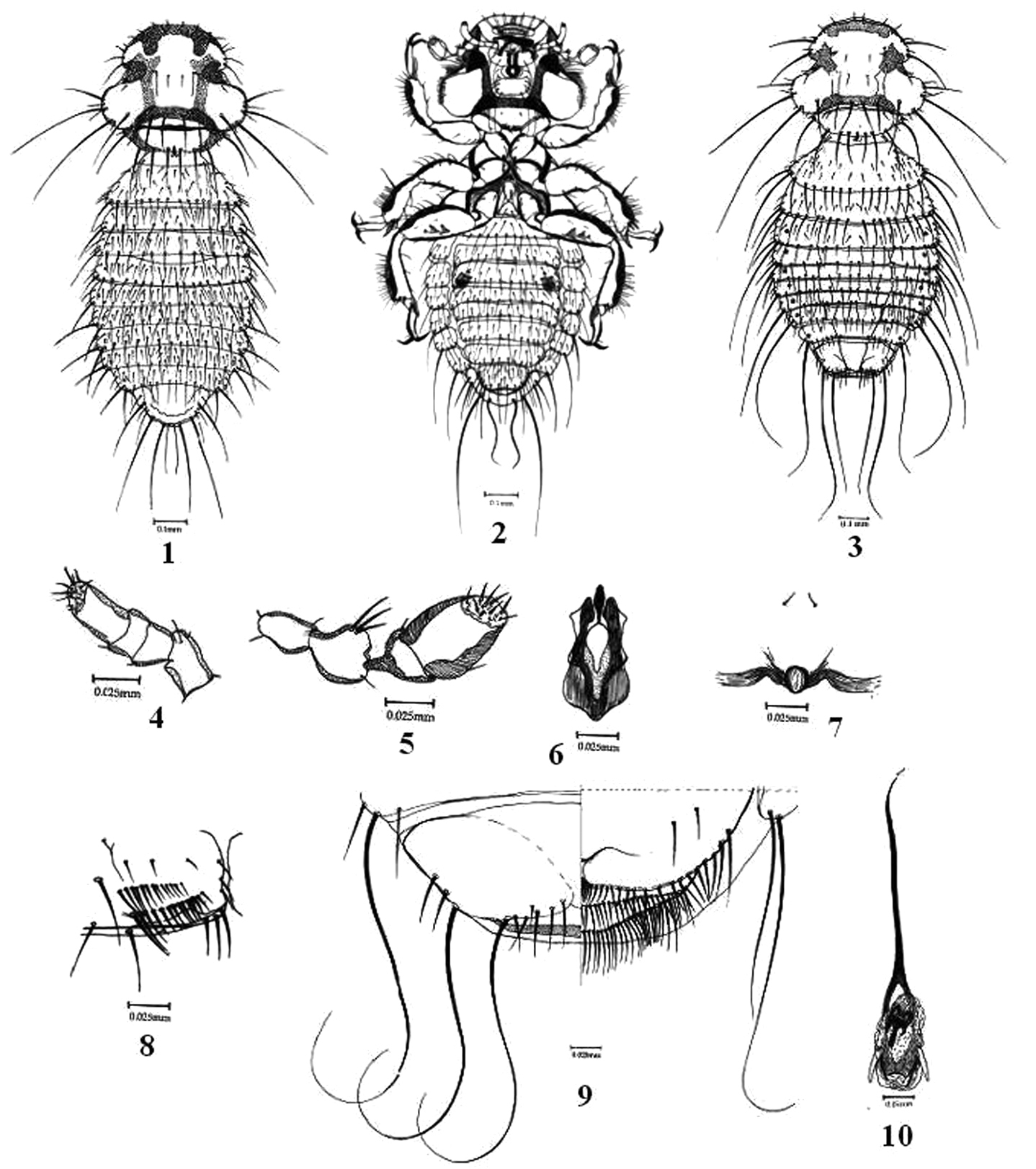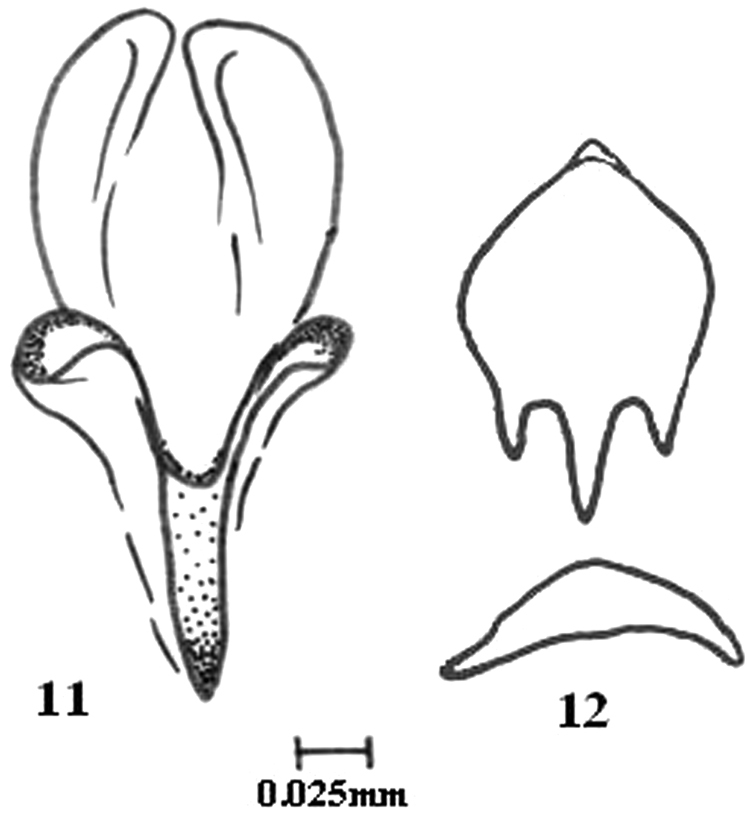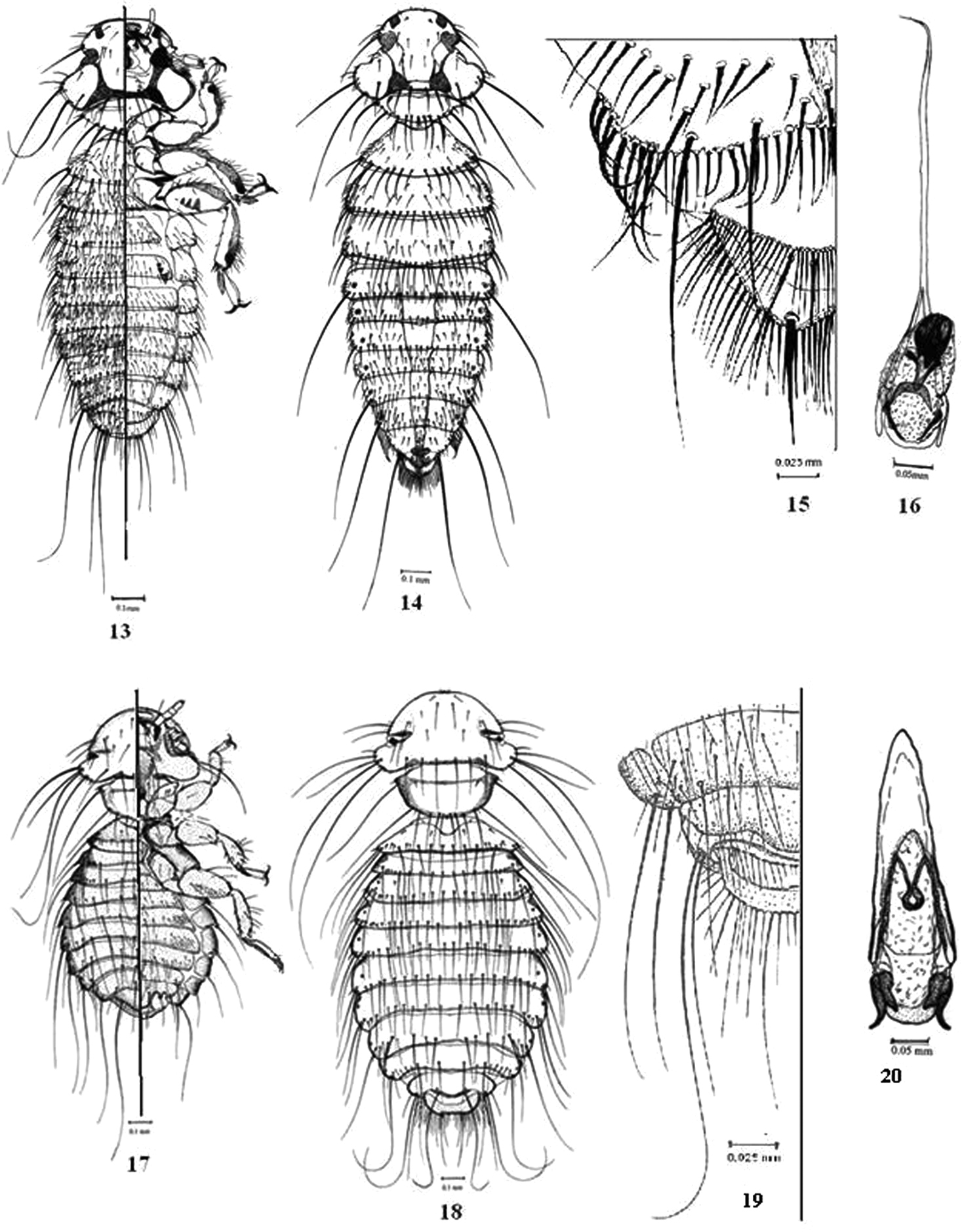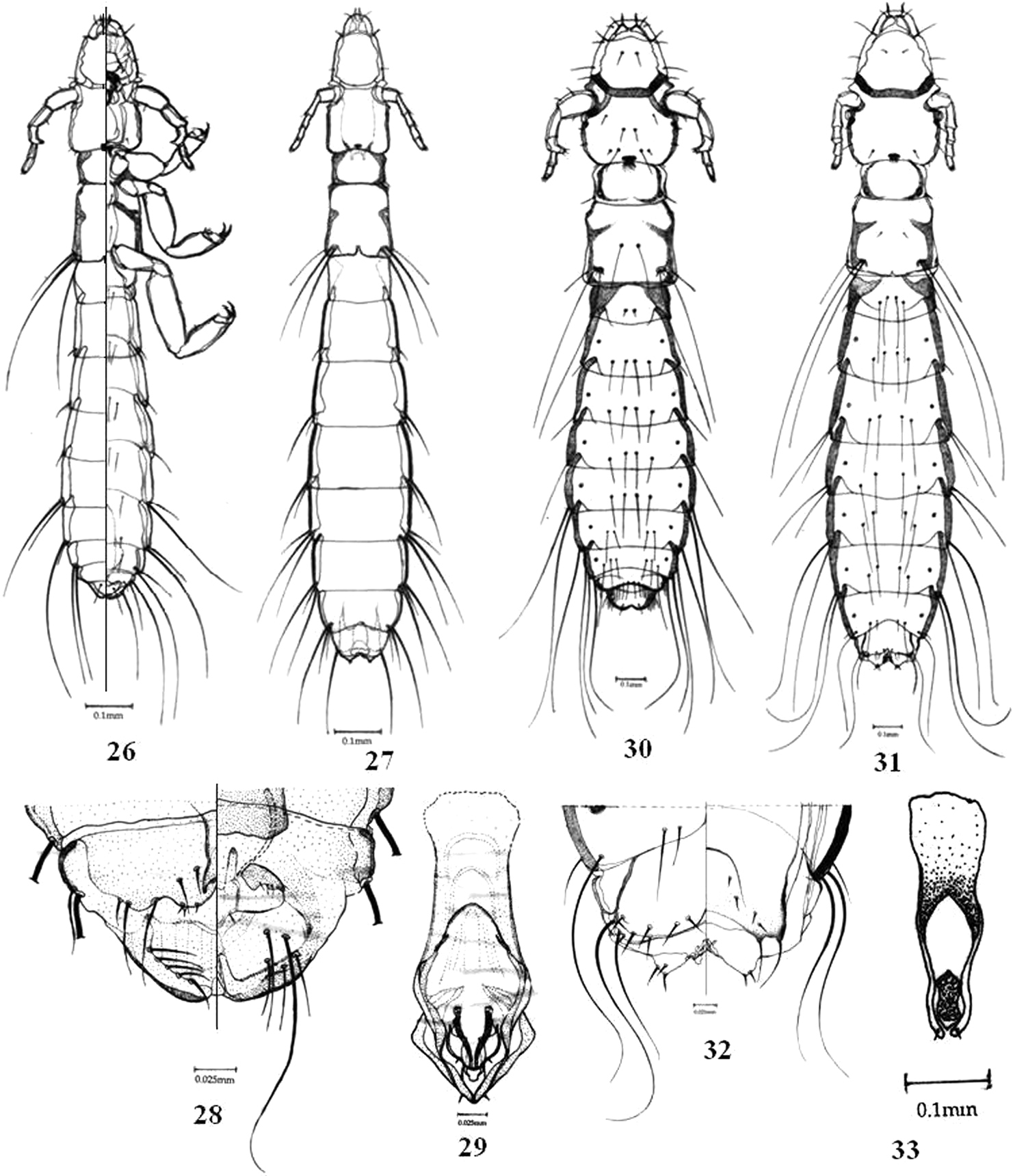






(C) 2012 Saima Naz. This is an open access article distributed under the terms of the Creative Commons Attribution License 3.0 (CC-BY), which permits unrestricted use, distribution, and reproduction in any medium, provided the original author and source are credited.
For reference, use of the paginated PDF or printed version of this article is recommended.
The chewing lice (Phthiraptera) of Columbidae (Columbiformes) from Pakistan are studied. Six species of chewing lice with new host records are recorded and one new species of the genus Colpocephalum is described from Columba livia in the Karachi region. All the columbid chewing lice from Pakistan are keyed out and the new species is illustrated and compared with the closest allied species.
chewing lice, Columbidae, Pakistan, new records, new species, taxonomy
The study of chewing lice in Pakistan has been neglected for many years, especially in the Sindh region of Pakistan. During 1940s to 1950s, Ansari published his work on lice from Pakistan, but his studies were restricted to Lyallpur (now Faisalabad), in the Punjab Province of Pakistan (
After Ansari (
The chewing lice used in this study were preserved on microscopic slides using a standard method (
AL Abdominal Length
DHS Dorsal Head Seta
GL Genital Length
HL Head Length
ML Metathorax Length
MW Metathorax Width
PL Pronotal Length
PML Paramere Length
POW Preocular Width
PW Pronotal Width
TL Total Length
TW Temporal Width
Results Chewing lice Species of Columbidae in PakistanBonomiella columbae Emerson, 1957 – New record
Campanulotes bidentatus Scopoli, 1763 (
Campanulotes compar Burmeister, 1838 – New record
Coloceras piageti Johnston & Harrison, 1912 (
Colpocephalum afrozeae sp. n.
Colpocephalum turbinatum Denny, 1842 (
Columbicola columbae L. 1758 (
Columbicola theresae Ansari, 1955 (
Columbicola tschulyschman Eichler, 1942 – New record
Hohorstiella lata Piaget, 1880 – New record
Hohorstiella modesta Ansari, 1951 (
Hohorstiella streptopeliae Eichler, 1953 – New record
Turturicola salimalii Clay & Meinertzhagen, 1937 – New record
Key to the chewing lice species of Columbidae in Pakistan| 1 | Maxillary palpi present; meso and metathorax separated | Amblycera, 2 |
| – | Maxillary palpi absent; meso and metathorax fused, forming pteronotum | Ischnocera, 7 |
| 2 | Postpalpal process present | Hohorstiella, 3 |
| – | Postpalpal process absent | 5 |
| 3 | Head much broader than long; anterior head margin broadly convex; abdomen short and oval; three abdominal sternites (st. III–V) with thick setal brushes | Hohorstiella modesta (Ansari) |
| – | Head broader than long; anterior head margin relatively more convex; abdomen large and oblong; two abdominal sternites with setal brushes | 4 |
| 4 | Postpalpal process short; antennal segment II small and rounded; prosternal plate small; abdominal sternite IV–V with thin setal brushes; vulval margin wide with thin short to long setae | Hohorstiella lata (Piaget) |
| – | Postpalpal process long; antennal segment II large and globulate; abdominal sternite III–IV with dense setal brushes; vulval margin narrow with thin microsetae to short fine setae | Hohorstiella streptopeliae Eichler |
| 5 | Head without ocular and occipital carinae; femur III and abdominal sternites without ctenidia | Bonomiella columbae Emerson |
| – | Head with ocular and occipital carinae; femur III and abdominal sternites with fine ctenidia | Colpocephalum, 6 |
| 6 | Femur III and abdominal sternite III with two fine ctenidia on each; male genital sclerite large, with short and fine latero–posterior points; penis short; female subgenital plate with medially short, stout setae | Colpocephalum afrozeae sp. n. |
| – | Femur III and sternite III with three ctenidia on each; male genital sclerite with long and slightly curved latero–posterior points; penis long; female subgenital plate with lateral tufts of setae | Colpocephalum turbinatum Denny |
| 7 | Head circumfasciate; temples large or broad, angulated | 8 |
| – | Head non–circumfasciate; temples short and rounded | 10 |
| 8 | Antennae dimorphic; scape very enlarged in male | Coloceras piageti (Johnston and Harrison) |
| – | Antennae monomorphic | Campanulotes, 9 |
| 9 | Female larger in size, not less than 1.58 mm long; ventral median setae on sternites VI and VII absent | Campanulotes bidentatus (Scopoli) |
| – | Female smaller in size, not more than 1.34 mm long; ventral median setae on sternites VI and VII present | Campanulotes compar (Burmeister) |
| 10 | Median head setae blade-like, on anterior dorsal plate; anterior dorsal plate divided medially; preantennal width narrow | Columbicola, 11 |
| – | Median head setae not blade-like, on anterior dorsal plate; anterior dorsal plate complete; preantennal width broad | Turturicola salimalii Clay and Meinertzhagen |
| 11 | Head length more than 0.55mm; posterior median head setae spike-like, shorter than anterior median head setae; male genitalia with triangular mesosomal plate, with groves directed towards median; female subgenital plate without lateral row of setae, grove with clear lateral indentations | Columbicola theresae Ansari |
| – | Head length less than 0.55mm; posterior median head setae hair like or spike like, equal or longer than anterior median head setae; male genitalia with medially divided mesosomal plate, with anterior grove, bearing pores in or out of the pigmented border; female subgenital plate with lateral row of setae, grove without indentations | 12 |
| 12 | Posterior median head setae hair-like and longer than anterior median head setae; male genitalia with relatively long, straight and posteriorly narrower parameres, mesosomal plate with shallow and narrow anterior grove, two pairs of pores present at mediolateral margins of mesosomal plate; female subgenital plate narrow with smooth posterior grove | Columbicola tschulyschman Eichler |
| – | Posterior median head setae spike-like, more or less equally long to anterior median head setae; male genitalia with short, stumpy parameres, curved inside outwards, mesosomal plate with large or deep anterior grove, anterior pair of mesosomal pores present at lateral margins within the dark pigmented borders; female subgenital plate relatively wider with wavy posterior grove, long and wide, bearing 4–8 pairs of medium to long setae | Columbicola columbae (L.) |
Family Menoponidae Mjöberg, 1910
http://species-id.net/wiki/Bonomiella_columbae
2 females, on Columba livia (Gmelin); Pakistan: Karachi; 21-V-2004; leg. Naz.
New record from Pakistan.
urn:lsid:zoobank.org:act:CC7DD2BC-D82F-4E06-89E7-8C3EB8A5739F
http://species-id.net/wiki/Colpocephalum_afrozeae
Figs 1– 12male, on Columba livia (Gmelin); Pakistan: Karachi; 20-VII-2006; leg. Naz, S.
8 males, 12 females, on Columba livia (Gmelin); Pakistan: Karachi; 20-VII-2006; leg. Naz, S.
6 nymphs, on Columba livia (Gmelin), with data as above.
Columba livia (Gmelin) (Columbiformes: Columbidae).
TL: male 1.242 (1.24–1.245) (Figs 1–2), female 1.330 (1.285–1.375) (fig. 3); HL: male 0.287 (0.286–0.288), female 0.302 (0.30–0.305); POW: male 0.318 (0.315–0.332), female 0.347 (0.345–0.35); TW: male 0.45 (0.445–0.455), female 0.492 (0.48–0.505); PL: male 0.12 (0.11–0.13), female 0.137 (0.135–0.14); PW: male 0.288 (0.255–0.322), female 0.332 (0.325–0.34); ML: male 0.135 (0.12–0.15), female 0.152 (0.15–0.155); MW: male 0.374 (0.322–0.426), female 0.51 (0.505–0.515); AL: male 0.658 (0.642–0.675), female 0.697 (0.685–0.71), GL: 1.03 (1.01–1.05), GW: 0.155 (0.15–0.16), PML: 0.055 (0.050–0.060).
(Figs 1–6). Anterior marginal carina very thick, with large and blunt marginal nodi; DHS 8–10 short fine to stout setae; DHS 15 long; occipital setae 21–22 thick setae of normal length; ventral subtemporal setae present; ocular and occipital nodi very well developed, connected with thick oculo–occipital and occipital carinae; maxillary palpi as in fig. 4; antennae (fig. 5) four segmented, pedicel large with short lateral process, bearing three stout sharp setae, flagellomere II long, oval with broad terminal disc; hypopharynx (fig. 6) very well developed.
Colpocephalum afrozeae sp. n.1 male dorsal view 2 male ventral view 3 female dorsal view 4 maxillary palp 5 antenna; 6 hypopharynx 7 prosternal plate 8 sternite IV with ctenidia 9 female terminalia ventral view 10 male genitalia
Colpocephalum afrozeae sp. n. 11 penis details 12 genital sclerite.
(Figs 1–3, 7). Pronotal carina very thickly sclerotized; pronotal seta 2 minute peg-like setae; lateral to posterior margin of pronotum with four long and at least two short setae; prosternal plate (fig. 7) weakly developed, short, with posterior margin convex and lateral margins absent, one pair of small microsetae anterior to the plate present; posterior margin of metanotum straight, with 8–10 normal fine setae, arranged equally without any gape; femur III with two ctenidia.
(Figs 1–3, 8). Male. Tergal plates complete, marginal setae from tergite I–VIII: 12, 14, 17, 18, 16, 16, 15 and 13 respectively; anterior tergal setae scattered, ranging from 14–28 microsetae; postspiracular seta long on segment II, V–VII, shorter on segments III–IV and VIII; sternal setae in double rows on sternites I–VII: 15, 24, 16 (+ two large ctenidia on segment III; fig. 8), 24, 21, 20 and 16 respectively. Terminalia (Figs 1–2): Terminal segment comprises segments IX and X, posteriorly rounded; large tergal plate usually without anterior setae, latero–posterior margin with two long macrosetae and posterior margin bears four long macrosetae and two short fine setae; sternites VIII forming a short subgenital plate, bearing dense scattered small thin setae; anal margin almost straight.
Female. Tergites I and II complete, wide and long, tergites III–VIII divided, tripartite, narrow and short; tergocentral setae on segment I and II long; tergal marginal setae from I–VIII: 20, 20–22, 16–18, 18–20, 16–19, 17, 18 and 14–16 respectively; postspiracular setae long on II–III, VI–VIII; segment VIII with one pair of long, latero–anterior setae; sternite I developed, sternite II–VIII complete and well sclerotized; sternal setae small short to fine, scattered all over the plates; sternite III with two long ctenidia (fig. 8). Terminalia (fig. 9): Terminal segment widely rounded posteriorly; tergite IX divided, median piece triangular; posterior margin of lateral plates with small fine setae and two pairs of long macrosetae; anus narrow, transverse with tapering ends; anal fringes bear forty three stout microsetae in anterior fringe and forty seven to fifty fine curved setae in posterior fringe; vulval margin medially concave, with small thick, stout curved setae, gradually larger at latero–posterior ends.
(Figs 10–12). Elongated; genital sclerite (fig. 12) short, with long and slightly curved latero-posterior points; genital lateral plates short and thick; basal plate thick and broad; median process long; penis (fig. 11) terminally narrow; parameres straight, tubular.
Colpocephalum afrozeae were collected from Columba livia on which Colpocephalum turbinatum has been reported previously. The two species of the genus Colpocephalum of Columba livia are different from each other. Colpocephalum afrozeae has the anterior margin of head broadly convex; anterior marginal carina thick; oculo-occipital carina thick; prothorax with two short marginal setae; femur III with two ctenidia; female tergite II with long tergocentral setae; postspiracular setae long on tergites II–III and VI–VIII; lateral plates of male genitalia very short; lateroposterior points of genital sclerite large and curved; median process reduced; female genital reticulation invisible; vulva medially concave; anus narrow and transverse.
Colpocephalum afrozeae has also some similarities with Colpocephalum arfakiani Price and Beer, but they have morphological differences, which consist of a thin anterior marginal carina; five long pronotal marginal setae; tergite II of female divided; tergite VIII with small triangular median piece; anal opening broad, with light fringe of short setae; male genital sclerite without latero-posterior points and long lateral plates are found in Colpocephalum arfakiani whereas the anterior margin very thick; four pronotal marginal setae long; tergite II of female complete; tergite VIII with large trapezoidal piece; anal opening narrow and transverse, with dense fringe of short setae in anterior margin and thick, long setae on posterior margin; male genital sclerite with long and curved latero-posterior points and short lateral plates are found in Colpocephalum afrozeae.
The present species is named after Mrs Hussan Afroze, mother of the first author.
http://species-id.net/wiki/Colpocephalum_turbinatum
Fig. 13–1691 males, 105 females, on Columba livia (Gmelin); Pakistan: Karachi; 21-V-2004, 23-IX-2007; leg. Naz.
13–16. Colpocephalum turbinatum Denny 13 male dorso-ventral view 14 female dorsal view 15 female terminalia 16 male genitalia. 17–20. Hohorstiella lata (Piaget) 17 male dorso-ventral view 18 female, dorsal view; 19, female terminalia 20 male genitalia.
http://species-id.net/wiki/Hohorstiella_lata
Fig. 17–2025 males, 39 females, on Columba livia (Gmelin), Streptopelia decaocta (Frivaldszky); Pakistan: Karachi; 21-V-2004, 04-VIII-2006; leg. Naz. New record from Pakistan.
http://species-id.net/wiki/Hohorstiella_streptopeliae
Fig. 214 females, on Columba livia domestica (Gmelin) (Fantail Pigeon breed); Pakistan: Karachi; 15-VII-2006; leg. Naz.
New record from Pakistan.
21 Hohorstiella streptopeliae Eichler, female, dorso-ventral view. 22–25 Campanulotes compar (Burmeister) 22 male dorso-ventral view 23 female dorsal view 24 female terminalia 25 male genitalia.
Family Philopteridae Burmeister, 1838
http://species-id.net/wiki/Campanulotes_compar
Fig. 22–2551 males, 72 females, on Columba livia (Gmelin); Pakistan: Karachi, Hyderabad, Khairpur mir’s; 21-V-2004, 04-VIII-2006; leg. Naz.
New record from Pakistan.
http://species-id.net/wiki/Columbicola_columbae
Fig. 26–2948 males, 73 females, on Columba livia intermedia (Gmelin), Columba livia neglecta Hume; Pakistan: Karachi; 21-V-2004, 23-IX-2007; leg. Naz. New host record from Pakistan.
http://species-id.net/wiki/Columbicola_tschulyschman
Fig. 30–335 males, 6 females, on Columba livia neglecta Hume; Pakistan: Karachi; 16-VIII-2007; leg. Naz.
New record from Pakistan.
26-29 Columbicola columbae (L.) 26 male dorso-ventral view 27 female dorsal view 28, male terminalia dorso-ventral view 29 male genitalia. 30–33 Columbicola tschulyschman Eichler 30 male dorsal view 31 female dorsal view 32 female terminalia dorso-ventral view 33 male genitalia.
http://species-id.net/wiki/Turturicola_salimalii
2 females, on Columba livia (Gmelin); Pakistan: Karachi; 16-VII-2005; leg. Naz.
New host record from Pakistan.
This study is the first survey of chewing lice of family Columbidae in Pakistan. Among the nine species found in this region, six species are recorded for the first time. Four of them, Campanulotes compar, Colpocephalum turbinatum, Columbicola columbae and Hohorstiella lata, are cosmopolitan (
Only two species of the genus Colpocephalum have been recorded from Columbidae, which are Colpocephalum longicaudum
Columbicola tschulyschman is also a regular pigeon parasite. It is known from three species of Columba including Columba livia neglecta, which is also foundin Pakistan (
The presence of Hohorstiella streptopeliae on Columba livia represents a case of straggling, because its type host is Streptopelia turtur arenicola (Hartlert) (
The authors owe their special thanks to Dr Mohammad Atique Akhter, Department of Zoology, University of Karachi; the late Dr Robert C Dalgleish and Dr Richardo L. Palma, and personal thanks to Dr. Vincent Smith for their critical reviews of the manuscript and valuable suggestions to improve the quality of this paper.




